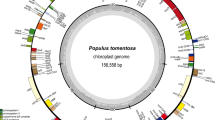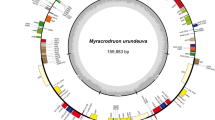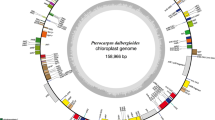Abstract
Populus caspica Bornm. (section Leuce and subsection Albida), one of the most endangered endemic tree species in the Hyrcanian Forest in Iran, has numerous morphological characteristics that are closely similar to Populus alba; to clarify their taxonomic relatedness and genetic differentiation and thus inform conservation strategies, we used the noncoding regions of chloroplast DNA (cpDNA; trnL-F and trnH-psbA) and the internal transcribed spacer (ITS). Leaf samples were collected from six populations across northern Iran. cpDNA and ITS fragments were amplified by universal primers using the PCR technique and directed sequencing. The results showed that P. caspica is genetically differentiated from P. alba, and two ITS variants were detected within some P. caspica individuals. Conflicts between topologies from ITS and plastid genomes were observed. High differentiation of P. caspica from the other Populus species shown in this study confirmed the diverging taxonomic status of this endangered species. We recommend in situ conservation measures (e.g., protected areas) for at least several populations of this species, especially in the plain regions of the Hyrcanian forest.



Similar content being viewed by others
References
Akbarzadeh Roshan F, Colagar AH, Yosefzadeh H (2013) Taxonomic status and genetic variation of the genus Castanea (Fagaceae) in Iran based on psbA and trnH-psbA. Rostaniha 14(2):229–237
Akhani H, Djamali M, Ghorbanalizadeh A, Ramezani E (2010) Plant biodiversity of Hyrcanian relict forests, N Iran: an overview of the flora, vegetation, paleoecology and conservation. Pak J Bot 42:231–258
Barnes BV, Pregitzer KS (1985) Occurrence of hybrids between big tooth and trembling aspen in Michigan. Can J Bot 63(10):1888–1890
Bellarosa R, Delre V, Schirone B, Maggini F (1990) Ribosomal RNA genes in Quercus spp. (Fagaceae). Plant Syst Evol 172:127–139
Besse P, Seguin M, Lebrun P, Lanaud C (1993) Ribosomal DNA variations in wild and cultivated rubber tree (Hevea brasiliensis). Genome 36(6):1049–1057
Bobola MS, Eckert RT, Klein AS (1992) Restriction fragment variation in the nuclear ribosomal DNA repeat unit within and between Picea rubens and Picea mariana. Can J For Res 22(2):255–263
Bouillé M, Senneville S, Bousquet J (2011) Discordant mtDNA and cpDNA phylogenies indicate geographic speciation and reticulation as driving factors for the diversification of the genus Picea. Tree Genet Genom 7(3):469–484
Brinegar C (2009) Assessing evolution and biodiversity in plants at the molecular level. Kathmandú Univ J Sci Eng Technol 5(2):149–159
Catalan P, Torrecilla P, Rodrıguez JAL, Olmstead RG (2004) Phylogeny of the festucoid grasses of subtribe Loliinae and allies (Poeae, Pooideae) inferred from ITS and trnL-F sequences. Mol Phylogenet Evol 31(2):517–541
Cervera MT, Cervera VMT, Sewell MM, Faivre-Rampant P, Storme S, Van Montagu M, Boerjan W (2004) Genome mapping in Populus. In: Kumar S, Fladung M (eds) Molecular genetics and breeding of forest trees. Haworth’s Food Products, New York, pp 387–410
Colagar AH, Saadati M, Zarea M, Talei SA (2010) Genetic variation of the Iranian Sclerotinia sclerotiorum isolates by standardizing DNA polymorphic fragments. Biotechnol 9(1):67–72
Colagar AH, Yusefi M, Zarei M, Yousefzadeh H (2013) Assessment of genetic diversity of Tilia rubra DC. by RAPD analysis in the Hyrcanian forests, north of Iran. Pol J Ecol 61(2):341–348
Degnan JH, Rosenberg NA (2009) Gene tree discordance, phylogenetic inference and the multispecies coalescent. Trends Ecol Evol 24(6):332–340
Dickmann DI, Isebrands JG, Eckenwalder JE, Richardson J (2001) Poplar culture in North America. NRC research, National Research Council of Canada, Ottawa, Ontario, Canada
DiFazio SP, Slavov GT, Burczyk J, Leonardi S, Strauss SH (2004) Gene flow from tree plantations and implications for transgenic risk assessment. In: Walter C, Carson M (eds) Plantation forest biotechnology for the 21st Century. Research Signpost, Thiruvananthapuram, pp 405–422
Ding TY, Fang CF (1993) New taxa of Salix L. from west China. Acta Phytotaxon Sin 31(3):277–280 (in Chinese with English abstract)
Fallah H, Jalali SGA, Tabari M, Chapolagh Paridari I (2012) Indicator plant species and site conditions of Persian Poplar populations in Hyrcanian Forest (Iran). Ann Biol Res 3(6):2763–2770
Feng J, Jiang D, Shang H, Dong M, Wang G, He X, Zhao C, Mao K (2013) Barcoding poplars (Populus L.) from western China. PLoS ONE 8(8):e71710
Fukuda S, Toh H, Hase K, Oshima K, Nakanishi Y, Yoshimura K, Tobe T, Clarke JM, Topping DL, Suzuki T, Taylor TD, Itoh K, Kikuchi J, Morita H, Hattori M, Ohno H (2011) Bifidobacteria can protect from enteropathogenic infection through production of acetate. Nature 469:543
Gong GT (2004) The geographic distribution and origin of Populus L. J Sichuan For Sci Technol 25(2):25–30 (in Chinese with English abstract)
Green MR, Sambrook J (2012) Molecular cloning: a laboratory manual. Cold Spring Harbor Laboratory Press, Cold Spring Harbor
Hamzeh M, Dayanandan S (2004) Phylogeny of Populus (Salicaceae) based on nucleotide sequences of chloroplast TRNT-TRNF region and nuclear rDNA. Am J Bot 91(9):1398–1408
Hamzeh M, Perinet P, Dayanandan S (2006) Genetic relationships among species of Populus (Salicaceae) based on nuclear genomic data. J Torrey Bot Soc 133(4):519–527
Heinze B (1998) PCR-Based chloroplast DNA assays for the identification of native Populus nigra and introduced poplar hybrids in Europe. For Genet 5(1):31–38
Holt SD, Horova L, Bures P (2004) Indel patterns of the plastid DNA trnL-trnF region within the genus Poa (Poaceae). J Plant Res 117:393–407
Keller I, Veltsos P, Nichols RA (2008) The frequency of rDNA variants within individuals provides evidence of population history and gene flow across a grasshopper hybrid zone. Evolution 62(4):833–844
Khasa DP, Nadeem S, Thomas B, Robertson A, Bousquet J (2003) Application of SSR markers for parentage analysis of populus clones. For Genet 10(4):273–282
Kimura M (1980) A simple method for estimating evolutionary rate of base substitutions through comparative studies of nucleotide sequences. J Mol Evol 16:111–120
Kojoma M, Kurihara K, Yamada K, Sekita S, Satake M, Iida O (2002) Genetic identification of cinnamon (Cinnamomum spp.) based on the trnL-trnF chloroplast DNA. Planta Med 68(1):94–96
Learn GH, Schaal BA (1987) Population subdivision for ribosomal DNA repeat variants in Clematis fremontii. Evolution 41:433–438
Leestmans R (2005) Le refuge caspiens et son importance en biogeographie. Linneana Belg 20(3):97–102
Lefèvre F, Kajba D, Heinze B, Rotach P, de Vries SM, Turok J (2001) Black poplar: a model for gene resource conservation in forest ecosystems. For Chron 77(2):239–244
Leigh JW, Bryant D (2014) PopART. Available at http://popart.otago.ac.nz. Accessed 28 Feb 20114
Leskinen E, Alström-Rapaport C (1999) Molecular phylogeny of Salicaceae and closely related Flacourtiaceae: evidence from 5.8S, ITS1 and ITS2 of the rDNA. Plant Syst Evol 215:209–227
Marshall HD, Newton C, Ritland K (2001) Sequence-repeat polymorphisms exhibit the signature of recombination in lodgepole pine chloroplast DNA. Mol Biol Evol 18(11):2136–2138
Mclain DK, Wesson DM, Oliver JH, Collins FH (1995) Variation in ribosomal DNA internal transcribed spacers 1 among eastern populations of Ixodes scapularis (Acari: Ixodidae). J Med Entomol 32(3):353–360
Nei M (1987) Molecular evolutionary genetics. Columbia University, New York, p 512
Nishimoto Y, Ohnishi O, Hasegawa M (2003) Topological incongruence between nuclear and chloroplast DNA trees suggesting hybridization in the urophyllum group of the genus Fagopyrum (Polygonaceae). Genes Genet Syst 78(2):139–153
Nitta JH, O’Grady PM (2008) Mitochondrial phylogeny of the endemic Hawaiian craneflies (Diptera, Limoniidae, Dicranomyia): implications for biogeography and species formation. Mol Phylogenet Evol 46(3):1182–1190
Pelser PB, Kennedy AH, Tepe EJ, Shidler JB, Nordenstam B, Kadereit JW, Watson LE (2010) Patterns and causes of incongruence between plastid and nuclear Senecioneae (Asteraceae) phylogenies. Am J Bot 97(5):856–873
Pirie MD, Vargas MPB, Botermans M, Bakker F, Chatrou LW (2007) Ancient paralogy in the cpDNA trnL-F region in annonaceae: implications for plant molecular systematic. Am J Bot 94(6):1003–1016
Quandt D, Müller K, Stech M, Frahm JP, Frey W, Hilu KW, Borsch T (2004) Molecular evolution of the chloroplast trnL-F region in land plants. Monogr Sys Bot Missouri Bot Garden 98:13–37
Raamsdonk LWV, Smiech MP, Sandbrink JM (1997) Introgression explains incongruence between nuclear and chloroplast DNA based phylogenies in Allium section Cepa. Bot J Linnean Soc 123(2):91–108
Rechinger KH (1982) Flora Iranica: Akademische Druck-und Verlagsanstalt Graz. University of Tehran, Tehran, p 549
Saghai-Maroof MA, Soliman KM, Jorgensen RA, Allard RW (1984) Ribosomal DNA spacer-length polymorphisms in barley: mendelian inheritance, chromosomal location, and population dynamics. Proc Natl Acad Sci 81(24):8014–8018
Schaal BA, Leverich WJ, Nieto-Sotelo J (1987) Ribosomal DNA variation in the native plant Phlox divaricata. Mol Biol Evol 4(6):611–621
Smith RL, Sytsma KJ (1990) Evolution of Populus nigra (sect. Aigeiros): introgressive hybridization and the chloroplast contribution of Populus alba (sect. Populus). Am J Bot 77(9):1176–1187
Sytsma KJ, Schaal BA (1985) Phylogenetics of the Lisianthius skinneri (Gentianaceae) species complex in Panama utilizing DNA restriction fragment analysis. Evolution 39(3):594–608
Taberlet P, Gielly L, Pautou G, Bouvet J (1991) Universal primers for amplification of three non-coding regions of chloroplast DNA. Plant Mol Biol 17:1105–1109
Tamura K, Stecher G, Peterson D, Filipski A, Kumar S (2013) Brief communication MEGA6: molecular evolutionary genetics analysis version 6.0. Mol Biol Evol 30(12):2725–2729
Tang L, Tang JM, Li Tan Si, Ju Ma X, Zhou ZQ (2015) ITS sequence variation and concerted evolution in the natural hybrid species Malus toringoides. Nordic J Bot 33:109–119
Tsai LC, Hsieh HM, Huang LH, Wang JC, Linacre A, Lee JCI (2006) Cannabis seed identification by chloroplast and nuclear DNA. Foren Sci Int 158(2):250–251
Tuskan GA, Difazio S, Jansson S, Bohlmann J, Grigoriev I, Hellsten U, Putnam N, Ralph S, Rombauts S, Salamov A, Schein J, Sterck L, Aerts A, Bhalerao RR, Bhalerao RP, Blaudez D, Boerjan W, Brun A, Brunner A, Busov V, Campbell M, Carlson J, Chalot M, Chapman J, Chen GL, Cooper D, Coutinho PM, Couturier J, Covert S, Cronk Q, Cunningham R, Davis J, Degroeve S, Déjardin A, Depamphilis C, Detter J, Dirks B, Dubchak I, Duplessis S, Ehlting J, Ellis B, Gendler K, Goodstein D, Gribskov M, Grimwood J, Groover A, Gunter L, Hamberger B, Heinze B, Helariutta Y, Henrissat B, Holligan D, Holt R, Huang W, Islam-Faridi N, Jones S, Jones-Rhoades M, Jorgensen R, Joshi C, Kangasjärvi J, Karlsson J, Kelleher C, Kirkpatrick R, Kirst M, Kohler A, Kalluri U, Larimer F, Leebens-Mack J, Leplé JC, Locascio P, Lou Y, Lucas S, Martin F, Montanini B, Napoli C, Nelson DR, Nelson C, Nieminen K, Nilsson O, Pereda V, Peter G, Philippe R, Pilate G, Poliakov A, Razumovskaya J, Richardson P, Rinaldi C, Ritland K, Rouzé P, Ryaboy D, Schmutz J, Schrader J, Segerman B, Shin H, Siddiqui A, Sterky F, Terry A, Tsai CJ, Uberbacher E, Unneberg P, Vahala J, Wall K, Wessler S, Yang G, Yin T, Douglas C, Marra M, Sandberg G, Van de Peer Y, Rokhsar D (2006) The genome of black cottonwood, Populus trichocarpa (Torr. & Gray). Science 313(5793):1596–1604
Wan XQ, Zhang F, Zhong Y, Ding YH, Wang CL, Hu TX (2013) Study of genetic relationships and phylogeny of the native Populus in Southwest China based on nucleotide sequences of chloroplast trnT–trnF and nuclear DNA. Plant Syst Evol 299(1):57–65
Wendel JF, Doyle JJ (1998) Phylogenetic incongruence: window into genome history and molecular evolution. Mol Syst Plants II. Springer, US, pp 265–296
Yi T, Miller AJ, Wen J (2004) Phylogenetic and biogeographic diversification of Rhus (Anacardiaceae) in the Northern Hemisphere. Mol Phylogenet Evol 33(3):861–879
Yousefzadeh H, Colagar AH, Tabari M, Sattarian A, Assadi M (2012) Utility of ITS region sequence and structure for molecular identification of Tilia species from Hyrcanian forests, Iran. Plant Syst Evol 298(5):947–961
Yousefzadeh H, Colagar AH, Akbarzadeh Roshan F, Tippery NP (2014) Taxonomic status and genetic differentiation of Hyrcanian Castanea based on noncoding chloroplast DNA sequences data. Tree Genet Genom 10(6):1611–1629
Acknowledgements
We are tremendously grateful to Dr. Mona Hamzeh, Department of Biology, Concordia University, for providing of some Canadian samples sequences. Also, we thank Fatemeh Mostajeran and Hamid Bina, Tarbiat Modares University, Noor, Mazandaran, Iran, for help with data collections.
Author information
Authors and Affiliations
Corresponding authors
Additional information
Project funding: This project is supported by grant funding from the Tarbiat Modares University and Mazandaran University.
The online version is available at http://www.springerlink.com
Corresponding editor: Hu Yanbo.
Electronic supplementary material
Below is the link to the electronic supplementary material.
Rights and permissions
About this article
Cite this article
Yousefzadeh, H., Colagar, A.H., Yousefi, E. et al. Phylogenetic relationship and genetic differentiation of Populus caspica and Populus alba using cpDNA and ITS noncoding sequences. J. For. Res. 30, 451–461 (2019). https://doi.org/10.1007/s11676-018-0785-4
Received:
Accepted:
Published:
Issue Date:
DOI: https://doi.org/10.1007/s11676-018-0785-4




